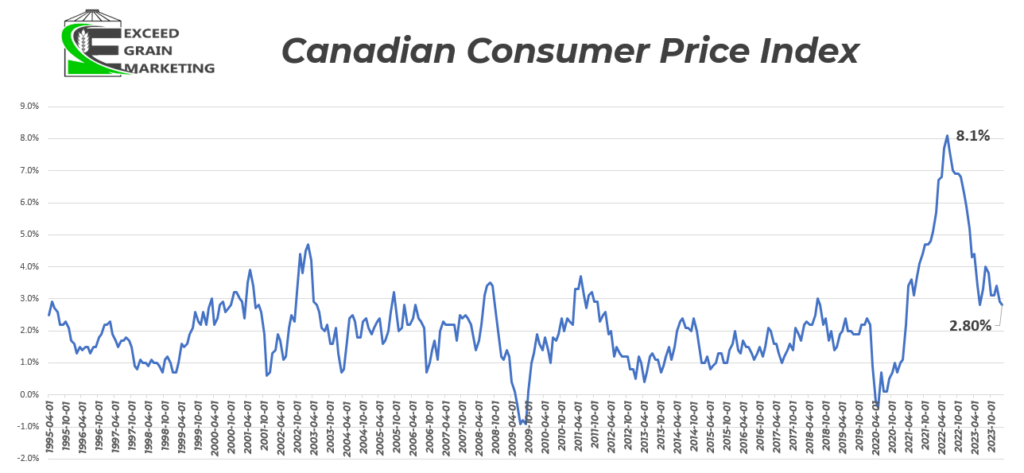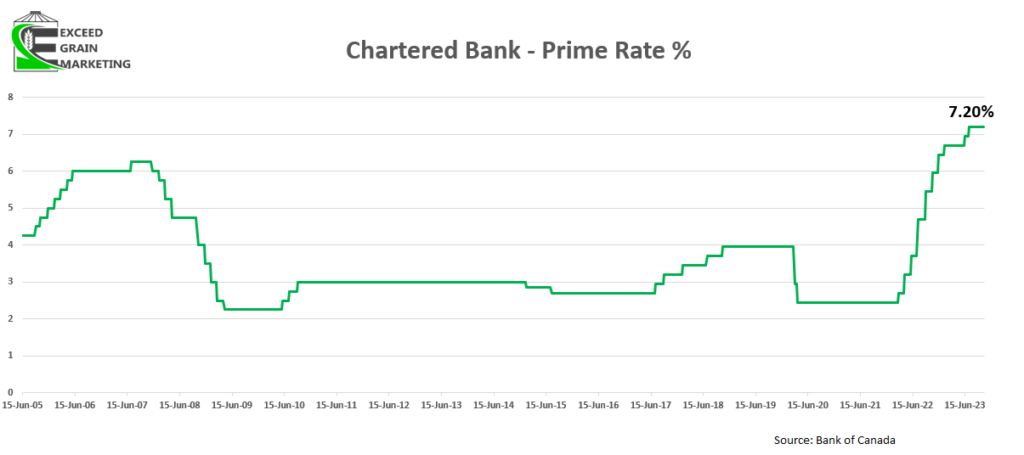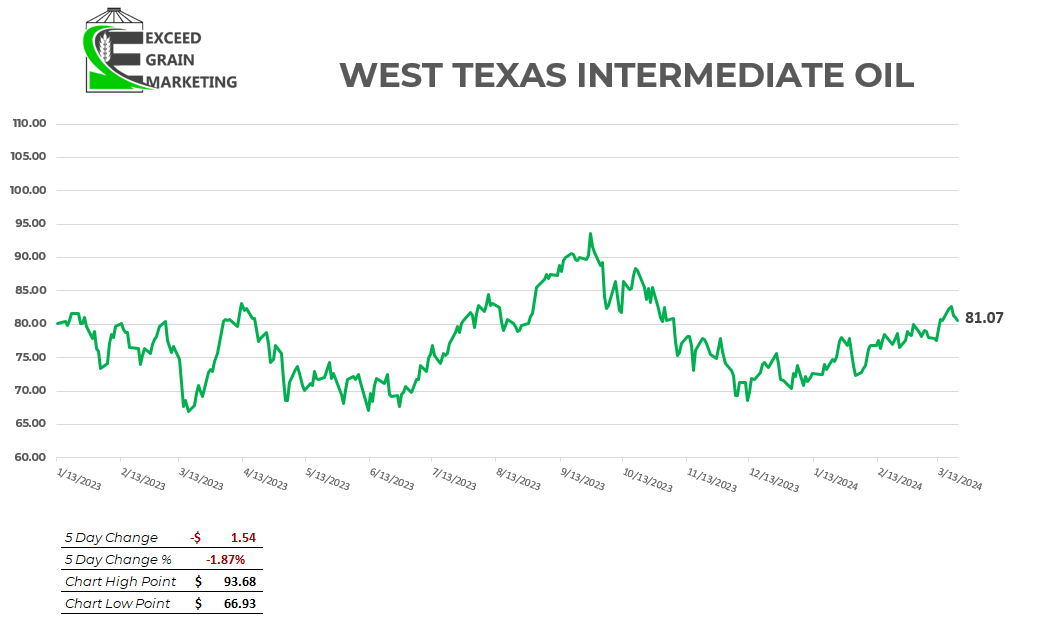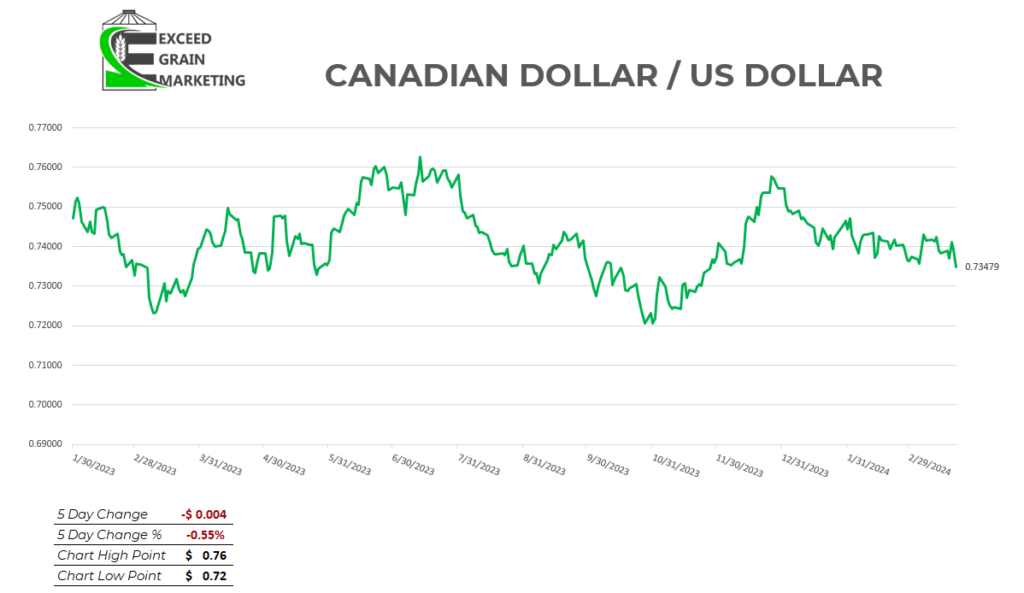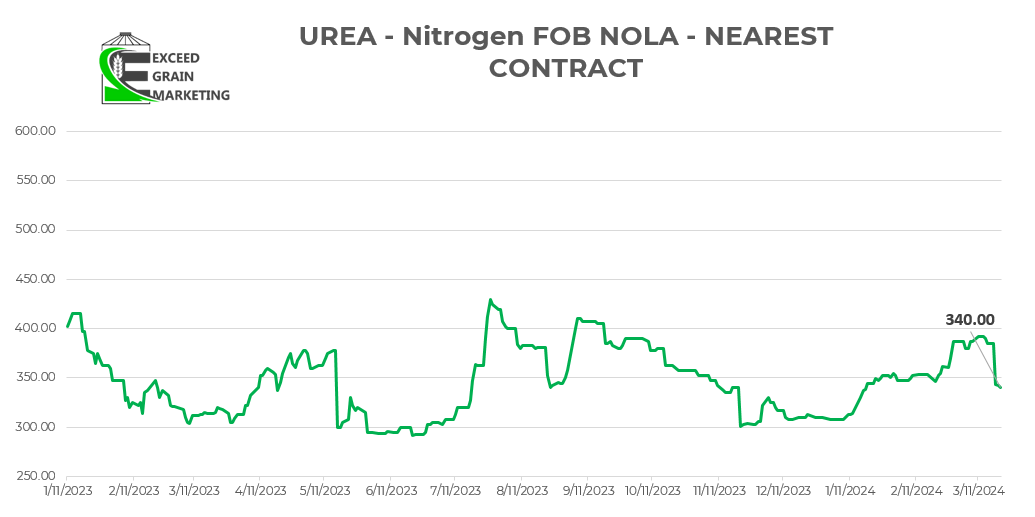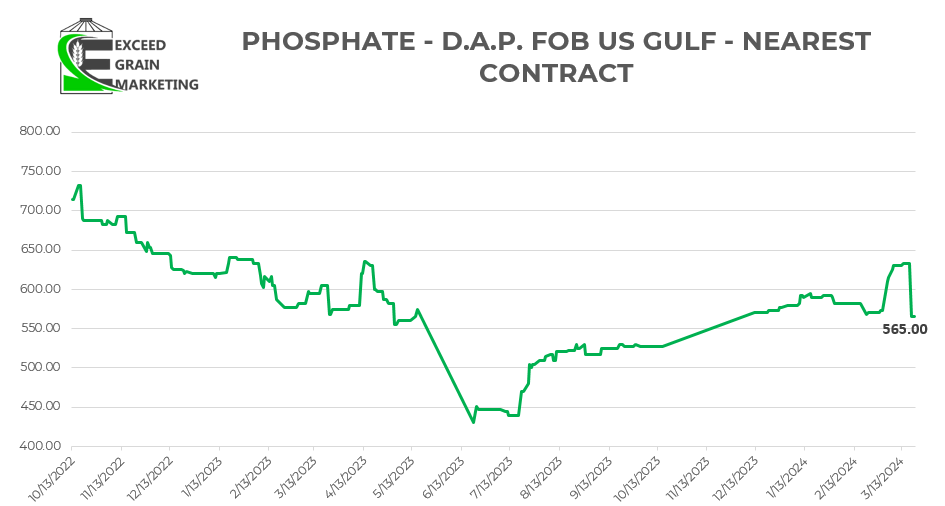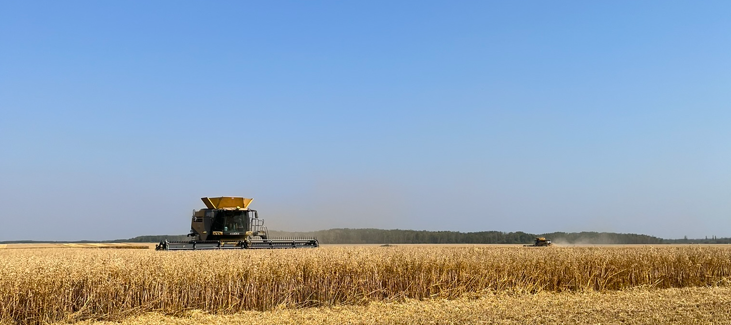Exceed Grain Marketing’s Client Exclusive report is dedicated to covering the ongoing trends and significant highlights within the local market, while simultaneously offering a perspective on the global landscape. This approach ensures a comprehensive understanding of the factors influencing the market at both local and international levels. Our aim is to deliver current, up-to-date information specifically tailored to the crops impacting your operation. Work with your Exceed Grain Marketing advisor to devise specific strategies that may work for your crop.
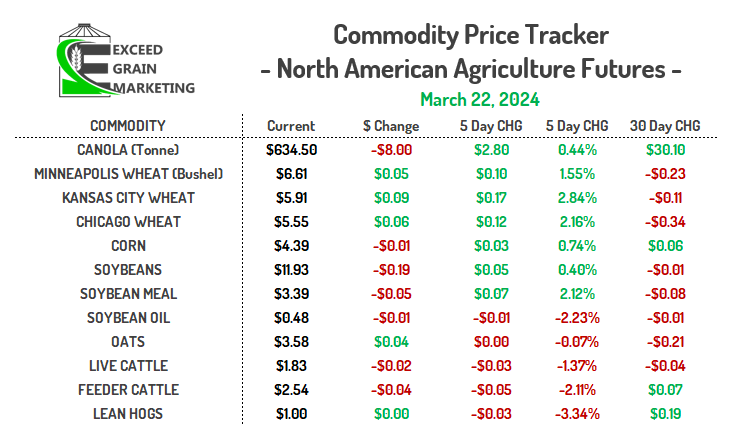
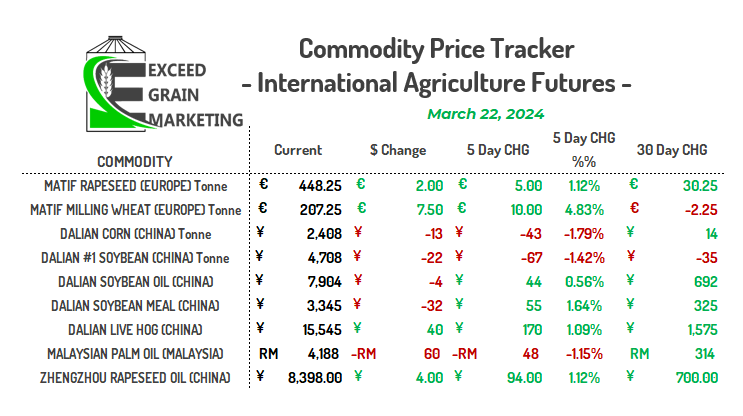
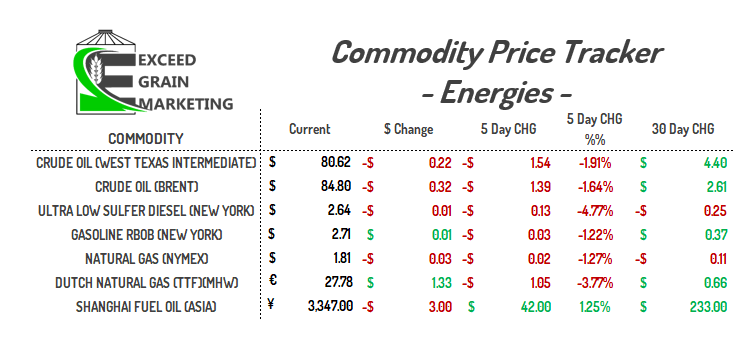
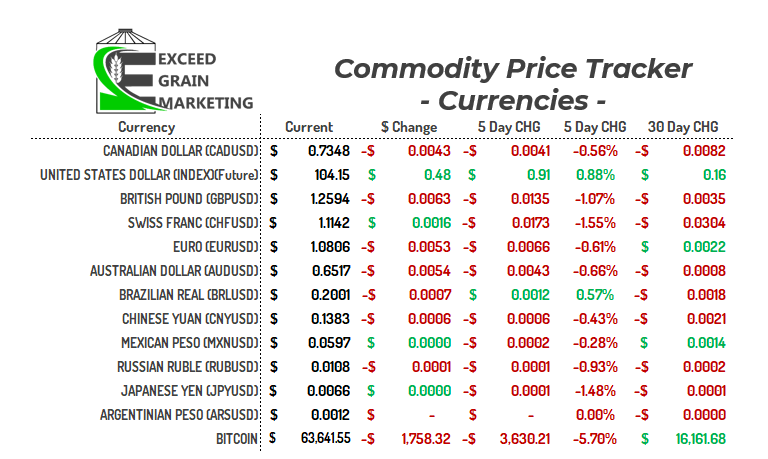
MARKET HIGHLIGHTS
- Canola and Wheat complex grabs some small gains for the week.
- Canola pulled back from its Wednesday high where it reached over the $650 per tonne mark and pulled back to close out the week at $634.50 per tonne.
- Spring Wheat grabbed $0.10 per bushel for the week.
- EU wheat and Rapeseed grabbed some ground for the week but losses were made in Malaysian Palm Oil.
- Chinese rapeseed oil futures had a positive trading week but Dalian Corn and Beans traded lower for the week.
- Part of todays pullback in the North American grains was attributed to a heavy precipitation forecast in the US corn and Soybean belt that have been mostly on the drier bias as we head into spring.
- European Union proposed tariffs on Russian grain on Friday. 95 Euro per tonne for grains. 50% for other crops. Subject to approval by the 27 member organization.
- Next Thursday we have the USDA Prospective Plantings report. Key one a year report highlighting the planting intentions of US producers as we get close to the northern hemisphere planting season.
- We will be shifting into the northern hemisphere growing season in a matter of weeks. EU winter wheat crops coming out of dormancy and the markets will be looking for weather stories as we trudge closer to spring.
- Some concerns in Russian wheat production regions getting dry. French wheat crop facing some troubles as well, supplies could get tight if weather does not improve in the coming weeks.
- Beginning in April we will get USDA weekly crop progress reports and the markets place high focus on these Monday afternoon reports. First report is always highly anticipated to see where winter wheat conditions come in.
- Buenos Aires Grain Exchange cut the Argentinian corn crop to 54 mmt from the prior 56.5 mmt due to earlier heat wave. Left soybeans unchanged at 52.5 mmt
- Egypt tendered for wheat and Algeria tendered for Durum this week, see notes in the sections below.
- Weekly grain exports for Canola came in just over 100,000 tonnes this week, down from last weeks 240,000 tonnes. Producer deliveries were reported to be strong this past week.
- Grains pulled back in the Thursday and Friday trade from the run earlier in the week. Rallies have found some farmer selling into these price spikes which has helped keep a lid on values.
- General pullback in global grains for the past couple sessions. Palm Oil and EU rapeseed last few sessions softened in the trade. Wheat values bouncing around throughout the week.
- Last week we had a few key reports. We ended last week with the USDA WASDE and then at the beginning of this week we had both the CONAB (BRAZIL) report and Statistics Canada Acreage Estimates for 2024
- Statistics Canada Acreage Estimates Analysis.
- Canola acres down year over year, Spring wheat and Barley were down as well.
- Chickpeas showing the largest percentage gain year over year and Flaxseed the largest drop.
- Oat acreage came in on the low side of pre report estimates despite a large year over year spike in acres. Oats still running some relatively low acreage numbers compared to years past. Take a look at chart below to see the past few years of acreage
- Canola came in near the bottom end of pre report estimates, but more in line with some longer term averages for acres.
- Stats Canada conducted the survey from December 14th – January 22nd and surveyed 9,600 farms. There have been significant changes in New Crop markets since this time and one can expect that final planted acreage will shake out a tad different than what was reported.
- Spread between exportable canola has grown week over week. Just a few short weeks ago, Canadian canola was trading below Australian values at export position. Canadian canola has regained some of its premium to the AUS crop. See FOB Chart Below.
- Canada being a cheaper origination place has helped out exports in recent weeks.
- China cancelled some US and Australian wheat last week, putting pressure on values.
- Some private analysts beginning to throw some concern into the EU winter wheat crop, beginning to trim some estimates production values. More below in the wheat section
- CONAB Brazil:
- CONAB lowered soybean production estimates from 149.4 to 146.9 mmt. The corn estimate was lowered from 113.7 to 112.8 mmt.
- US Soybean crush report was released last Friday. For the month of February US crushers processed a record 186 million bushels vs 165 million bushels same month last year. Crush came in higher than estimates and also resulted in a higher soybean oil stock levels as well.
- Western Canadian Producers can now access spring provincial crop insurance prices for the 2024 crop year. Saskatchewan was released last week while Alberta and Manitoba have been out for a few weeks now
- United States spring crop insurance prices released. Lowest coverage since 2020 in most cases.
- European wheat production estimates were dropped by about 1mmt here last week for the crop due to some adverse weather conditions.
- Prior report section
- The USDA Ag Outlook Forum placed initial acreage at the following mid February:
- Corn acres 91 million vs 91.8 pre report estimate
- Soybean acres 87.5 million acres vs 86.5 million pre report estimate
- Wheat acres at 47 million vs 47.5 pre report
- USDA WASDE February 8th Report Highlights (Month Prior)
- USDA’s Estimate at the Brazilian crop came in at 156.0 mmt, down from 157 mmt last month. The problem the market found with this number is that the market wanted to see more of a 153 mmt figure. Overall the report was seen as generally bearish.
- Global Corn Ending Stocks cut to 322.1 mmt down from 325.2 mmt in last months WASDE
- Global Soybean Ending Stocks bumped higher to 116 mmt from 114.6 mmt in the last WASDE
- Global Wheat Ending Stocks adjusted down very slightly by about half million tonnes and comes in at 259.4 mmt
- US ending stocks all higher for their crops
- The USDA kept Canadian canola exports at a 7.6 mmt export figure. We are tracking below 6 mmt on actual exports right now. There is a wide discrepancy in export figures here but it should be noted where other agencies stand.
- CONAB report out Thursday February 8th (Month Prior – March 12th is the most recent update – See Above)
- Cut soybean production to 149.4 mmt down from 155.3 mmt in the January report. Brazil also lowered its soy exports for the year to 94.2 mmt from 98.5 in the January report.
- Corn production also cut 7 mmt to 201 mmt total production
- Stats Canada canola December 31st stocks came in at 12.85 mmt vs expectations in the 13.0 mmt area. Higher for the time of year last year and the year prior, but the 4th smallest in a decade overall. Not exactly abundant as the market makes it out to be. The problem will be how accurate these numbers are first off and how our usage is through the end of the year. If exports continue to lag, then the figure will be of less significance. Something to keep an eye upon
- Interesting to note that some crops came in at the tightest in a long time. Oats were a crop that stood out as well. Aside from December of 2021, oat stocks came in at the tightest in a decade.
- Peas, Durum, Lentils all worth taking a look at as well. Big question remains demand. Durum needs to get more tender business which it has been loosing out upon. Need to pick up export pace for most crops
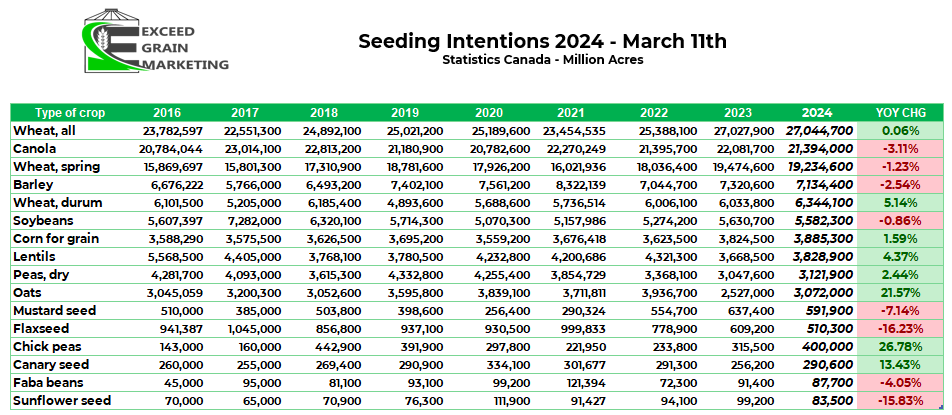
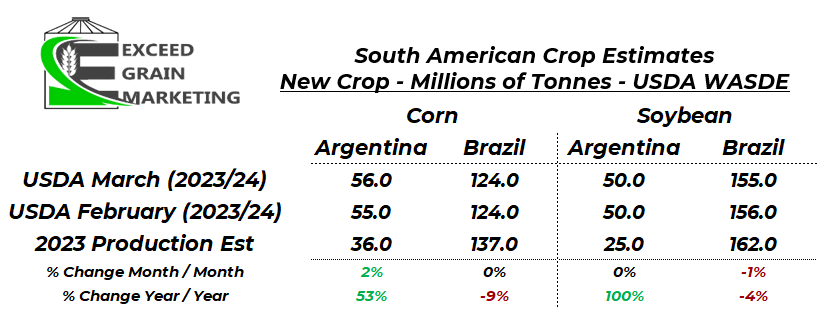
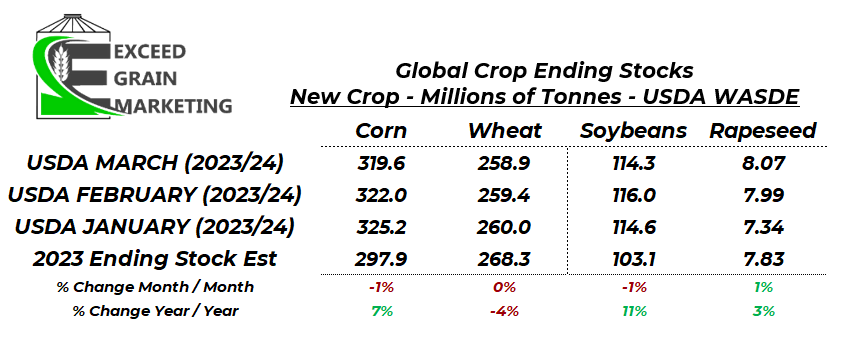
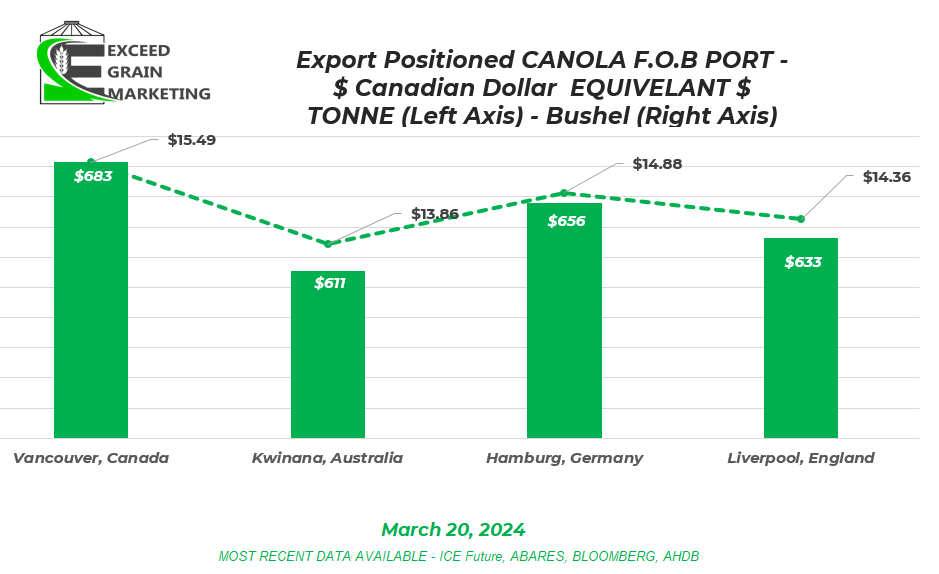
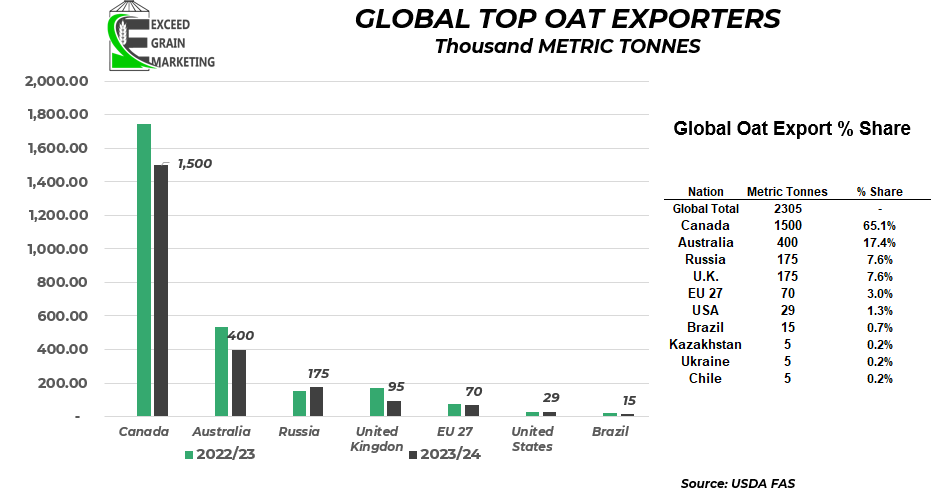
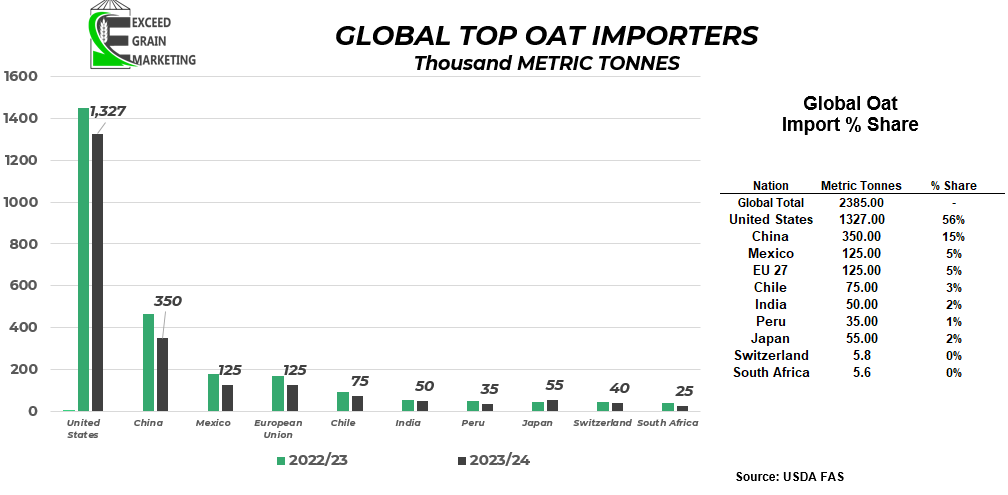
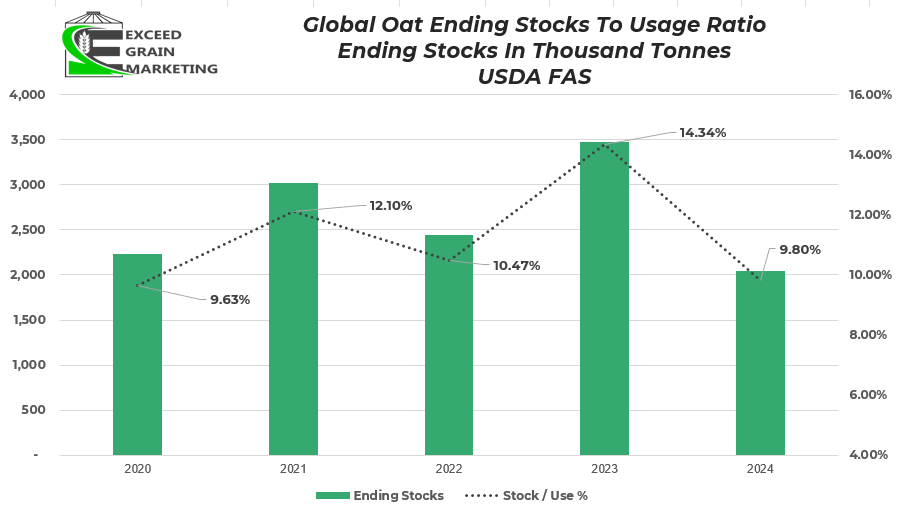
WESTERN CANADIAN CROP NOTES
Canola:
- We hit some important sales targets for our grain marketing clients this past week due to the recent run up in futures.. See recommendation section below.
- Crushers filling up domestically for the front months as producer selling took up much of the front month capacity. Most crushers bidding May onwards. If need crusher movement, need to build a plan around that. June/July/August is where most capacity lies within the crush.
- Canola now pricing more expensive than Australian Canola after being cheaper than them for the past few weeks. The difference between exporter bids has narrowed up significantly in recent weeks. Canola carried such a premium to Australian canola and EU canola through the first half of the marketing year. It narrowed up significantly for several week but is showing signs of building that spread again. Chart above shows most recent bids at some key export regions in Canada, Germany, Australia and England.
- Canola exports two weeks ago were some of the best of the marketing year. 240,000 tonnes. This past week was just over 100,000 tonnes. Still tracking pace for 6mmt
- Current export pace of 6.0 mmt is not great overall and would be one of the lowest levels of exports in decades. See chart below for reference
- We need to grab exports on the tail end of the marketing year to maintain a reasonable carryout in the market.
- Crush is running at a very impressive pace, could hit a 11mmt record. Markets need to see exports pick up to get any sort of strength into the domestic trade (Basis).
- Canola will trade at the mercy of foreign veg oils for the time being (Palm, Soy, Rapa). Canola has been taking it a bit harder than its competitors although recently. Palm oil has been quite strong in recent weeks.
- South American harvest and export demand will dominate the trade headlines, Western Canadian weather will pick up more of the news come closer to spring.
- Crusher bids still dominate but are falling closer to exporter prices, depending on the month. Most exporters sit close to the $14.00+ mark today, depending on region and Basis levels. Crushers still hold the leading bids, but the regions are getting fewer and further between and months are getting tighter.
- For a more in depth analysis on Canola Specifically, check out our Canola Fundamental report by clicking here: Canadian Canola Market Fundamentals – Q1 2024

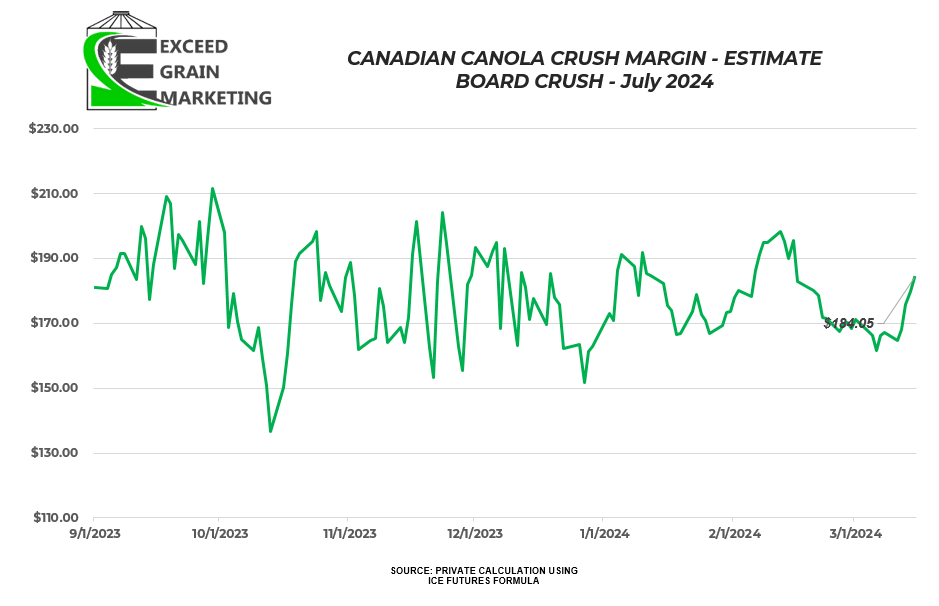
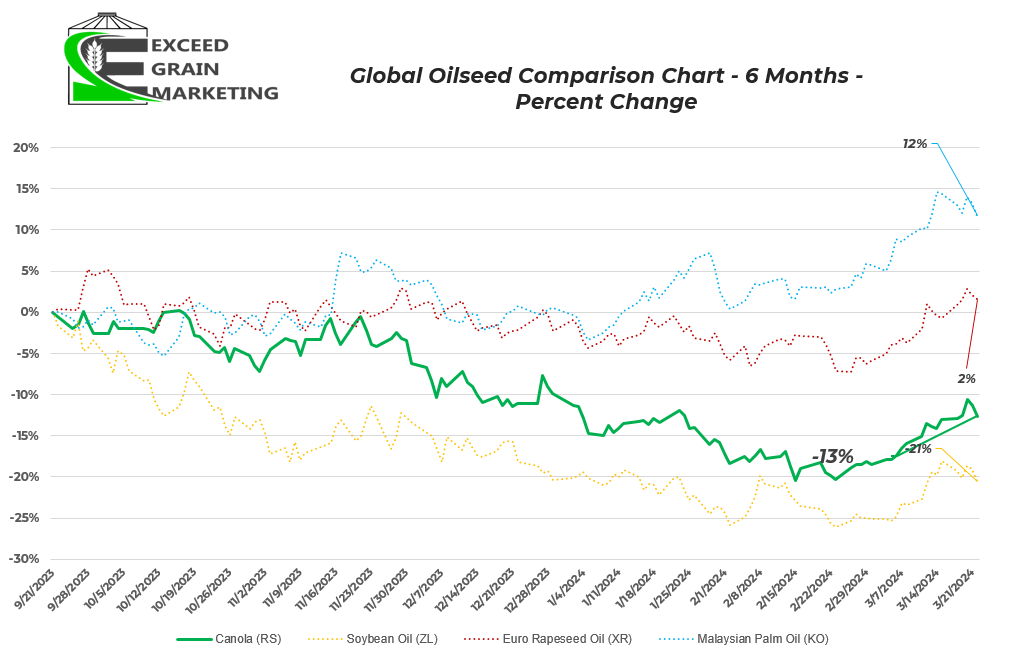
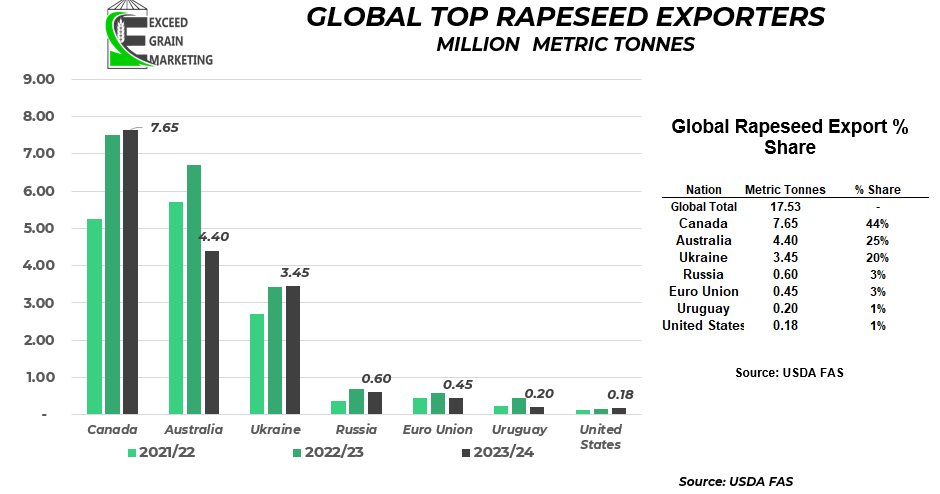
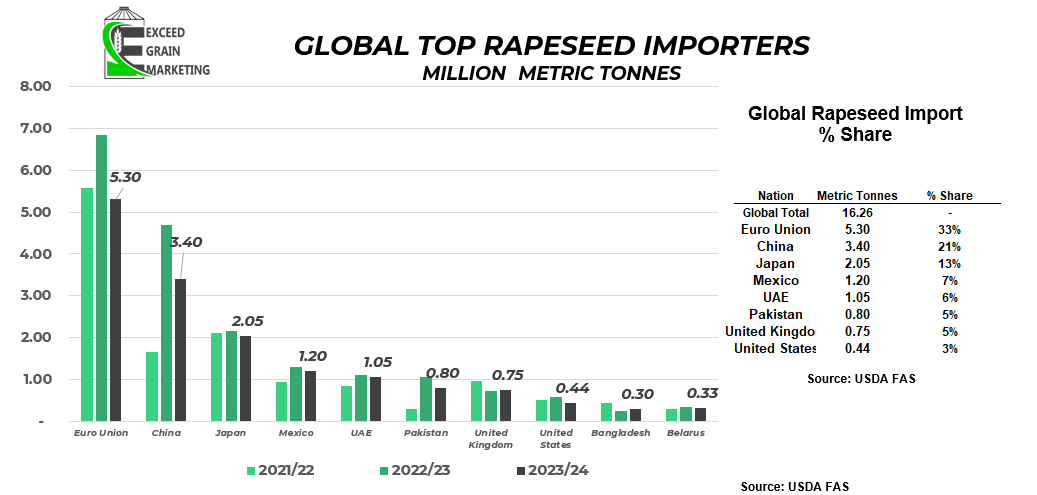
Spring Wheat:
- Global wheat values diminished here recently as Russian and Ukrainian origin grain pushing below that $200 to $220 per tonne level on some recent tenders. Some reports of Russian wheat trading for as low as $200 per tonne in recent days for low protein wheat 11.5%.
- Egypt bought Bulgarian and Romanian wheat for around $235 per tonne this week.
- China Cancelled some US and Australian wheat purchases it had committed to earlier. This has put pressure on wheat markets this past week.
- Wheat domestically in Canada trading around that $8.50 mark for a #1 13.5% protein at earlier parts of the week. Fridays close of spring wheat drug down values. Some posted bids sub $8.00. Exporters having a bit more of a challenging time getting Canadian wheat to price globally. Bids highly variant depending on area. There can be a $0.50 per bushel swing in a couple hundred mile radius.
- Looks like Black Sea regions willing to dump grain here before summer. New crop will be in the system starting July 2024 so exporters looking to keep product moving.
- Canadian Wheat exports and domestic usage is still considered very strong. At the current pace of exports and domestic usage, rationing will be needed. This does not always mean price correlates accordingly, as we have seen in recent weeks. Prices have seen producers selling into them.
- Wheat exports expected to easily surpass last years levels at current pace and are on track for an 8% increase year over year. Likely not able to make that happen although as rationing will supersede this.
- Canadian wheat of good quality. 97% graded as either a #1 or #2 HRSW
- 80% had falling number above 350 seconds
- Wheat trade right now is mostly demand based. We have a good idea on global supplies for the most part.
- Forecasted wheat global and domestic ending stocks coming in at the tightest levels since the 2015/16 crop year.
- Next thing market will be watching for is crop progress in the US and EU winter wheat crops and Spring Wheat planting conditions in Europe. This will be more relevant come April / May. Start of April we will get into the regular USDA Reporting schedule for crop conditions and progress.
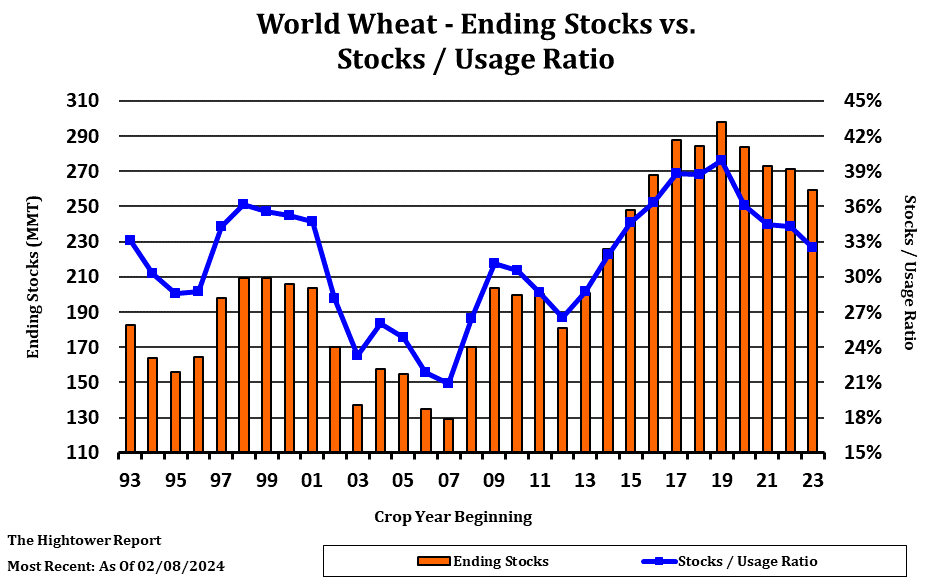
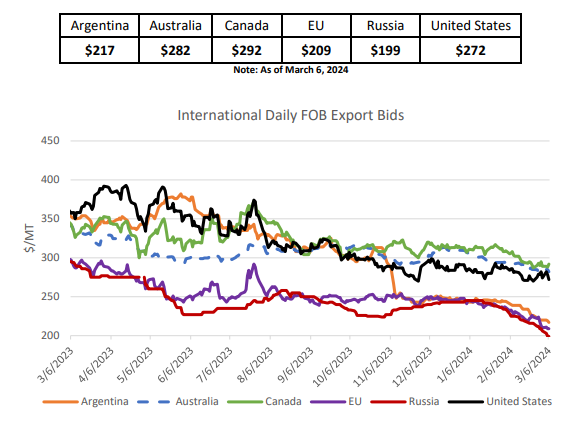
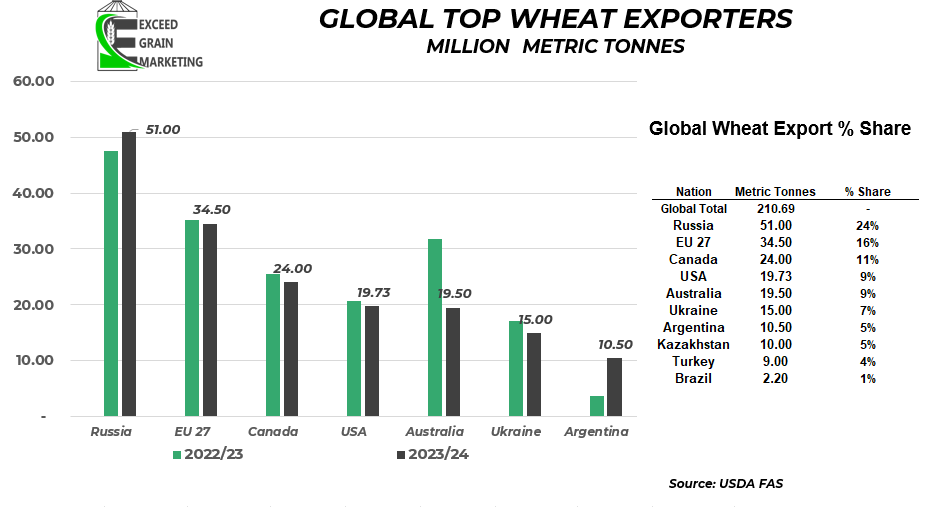
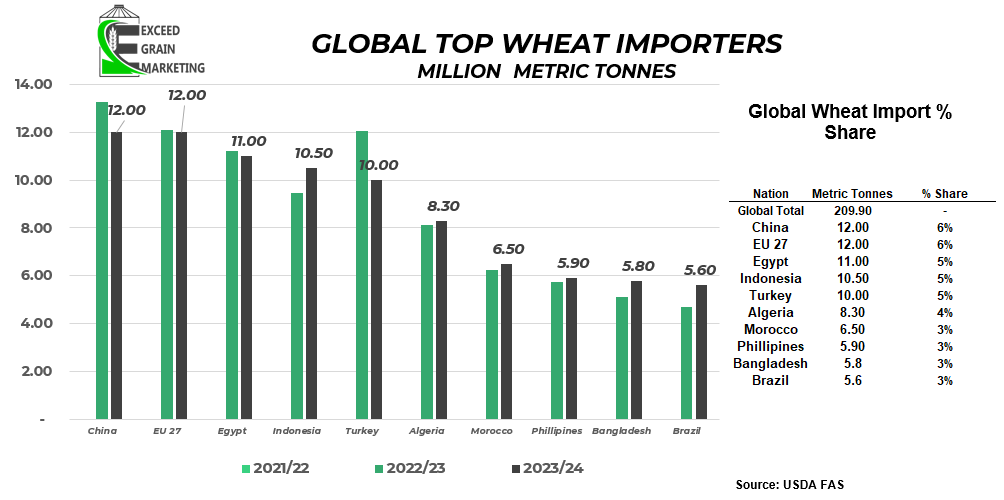
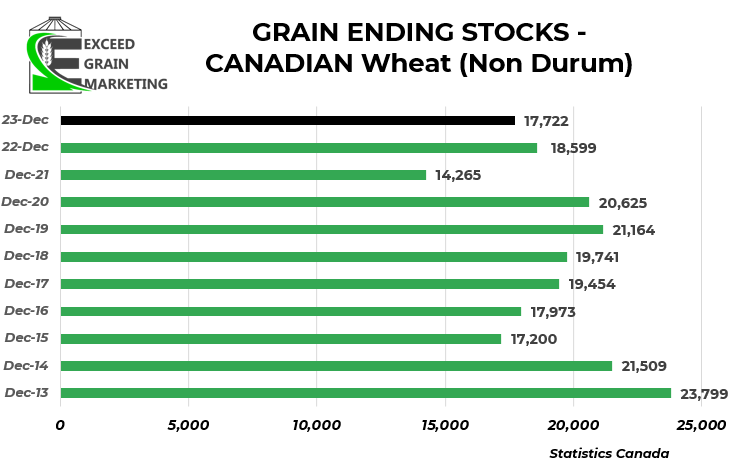
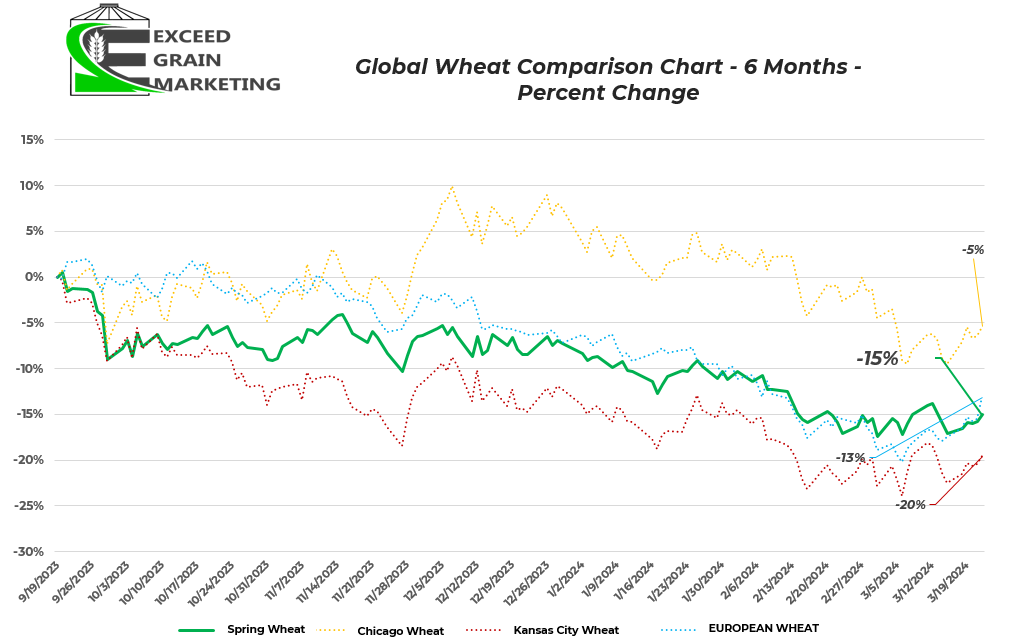
Special Crops
- Special crop markets closely watched Mondays release on acreage estimates from Stats Canada.
- Barley acreage drops to 7.1 million acres. Fits in line with some trendline averages
- Barley prices lower than last year, as with many crops. Some $5.00+ feed opportunities avaliable central Sask. Greater as you move closer to Feed centers. Add $1.25 to $1.50 for Malting.
- Durum acres up 5% year over year. One of the largest acreage estimates in recent years
- Lentil and Pea acres up year over year but still not out of line with recent history.
- Watch prices in the coming weeks to see if we get any shift in general in acres. We could see some significant swing acres depending upon producer sentiment towards moisture and market conditions.
- Algeria tendered for Durum. Sounds like 200,000 tonnes in the $390 per tonne range. Looks like Canada picked up a couple of these cargo’s for shipment in the next couple months.
- Canadian peas will face stiffer competition going forwards into China as some Black Sea peas able to price into the region.
- Canadian red lentils also competing with a larger Australian crop. Indian lentil harvest taking place here in the coming weeks and crop is expected to be of a healthy size. Looks like higher availability for global export market
- India reduced Yellow Pea import tariffs from 50% down to 0% was extended for another month until the end of April 2024. Was only in place until end of March but another month was added to get exports into the nation. Pea bids did show some strength about two weeks ago but have toned back in recent days as the exporters square up their positions ahead of key deadlines
- Durum exports lagging behind last years pace. Canadian durum has been missing out on some recent tenders into North Africa. Durum exports have somewhat disappointed traders as we missed some key export opportunities early on due to some better than expected Mediterranean crops. New crop Durum $9.50 still available for the fall
- Durum growing regions of Canada remain parched, producers somewhat hesitant to price aggressively on new crop.
- Red Lentil reduced import tariffs extended until March of 2025
- Red Lentil new crop sitting around $0.32 and $0.52 for greens. Act of God coverage bids slightly lower
- Yellow Peas – Old crop yellows $12+ on the renewal of the India tariff exemption. Bids are not consistent amongst buyers. New crop $10.00 range. We will need to see further tariff exemptions to keep premium in the market.
- Flax Bids in the $16.00 central prairies. Some large divergence in bids so please look into where you are pricing. Flax bids have been picking up here recently. Speculation of a sale through the seaway made for spring and concern about Kazakh supplies and whether new EU tariffs against Russian grains will affect supplies.
- Feed Barley has picked up some ground. $5.00 bids more common than two weeks ago . Still competing heavily with US corn origination. New crop feed barley $5.00 in some cases. Big Spreads
- Feed Barley at the mercy of US corn crop prices and Currency. Corn imports still pencil out into Canadian feeders.

Latest Key Fundamental Report Highlights
- STATS CANADA ( DECEMBER)
- March 11th we got Principal Field Cropping Areas – See above
- December 5th production estimates. Stats Canada report came in and was mostly as expected but higher than the prior report released pre harvest.
- Canola- 18.3 mmt vs 18.3 mmt pre report estimate
- Spring Wheat – 24.7 mmt vs 24.0 mmt pre report estimate
- Barley 8.9 mmt vs 8.6 mmt pre report
- Oats 2.6 mmt vs 2.6 mmt pre report
- Durum 4.0 mmt vs 4.1 mmt pre report
- Corn 15.1 mmt vs 15.0 mmt pre report
- Soybeans 6.98 mmt
- Lentils 1.7 mmt vs 1.7 mmt pre report
- Peas 2.6 mmt vs 2.6 pre report
- Flax 0.272 vs 0.290 pre report
- Most of the production numbers are higher than they were in the early days of harvest when ideas for the canola crop were floating around a high 17’s number. Same could be said for Durum and a few other select crops.



Currency – Energies – Fertilizer
- Bank of Canada Stays Put with current interest rates at the latest interest rate meeting. Prime sits around 7.2% at major Canadian banks. Hinted that we could be higher for longer. Cuts will not be significant if they do come. The Bank of Canada has also recently hinted that one could face another rate hike but it is hesitant to do so given that Canadians are feeling the pinch of higher rates.
- Canadian CPI Still “Sticky” and sits at 2.9% as of the latest announcement in February.
